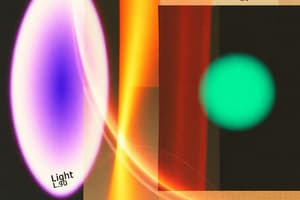Podcast
Questions and Answers
What is light?
What is light?
What happens when light encounters objects with shorter wavelengths?
What happens when light encounters objects with shorter wavelengths?
How do wavefronts of light propagate?
How do wavefronts of light propagate?
Which part of the electromagnetic spectrum does visible light belong to?
Which part of the electromagnetic spectrum does visible light belong to?
Signup and view all the answers
Who formulated equations describing how electric and magnetic fields give rise to light during the mid-Victorian times?
Who formulated equations describing how electric and magnetic fields give rise to light during the mid-Victorian times?
Signup and view all the answers
What technique in materials sciences and biology was developed based on Arthur Compton's discovery in 1921?
What technique in materials sciences and biology was developed based on Arthur Compton's discovery in 1921?
Signup and view all the answers
Who are the researchers credited with developing laser technology based on Einstein's theory of stimulated emission?
Who are the researchers credited with developing laser technology based on Einstein's theory of stimulated emission?
Signup and view all the answers
How has the study of quantum entanglement between photons impacted technology?
How has the study of quantum entanglement between photons impacted technology?
Signup and view all the answers
What field benefits from the interpretation of galaxy formation and comprehension of distant astronomical events through the understanding of light and optics?
What field benefits from the interpretation of galaxy formation and comprehension of distant astronomical events through the understanding of light and optics?
Signup and view all the answers
Which technology enabled secure data transmission over vast distances and paved the way for telecommunications via fiber optic cables?
Which technology enabled secure data transmission over vast distances and paved the way for telecommunications via fiber optic cables?
Signup and view all the answers
Study Notes
Exploring Science through Light's Lens
Light is one of the most fundamental aspects of our everyday lives yet also a captivating mystery waiting to be unraveled by science. This brief introduction will dive into some foundational concepts related to light and its significance within scientific disciplines.
What Is Light?
At its core, light refers to electromagnetic waves that carry energy and information traveling at incredible speeds through space. These waves oscillate transversely — perpendicular to their direction of travel. Visible light is just a small part of this spectrum, which spans from radio waves all the way up to gamma rays.
How Does Light Travel?
A key concept regarding light is that it propagates as wavefronts emanating outward from sources like stars or lamps. We experience these wavefronts when they encounter objects; those with shorter wavelengths appear blue while longer ones appear red due to how they interact with our eyes and brain. These properties have been essential since humanity first began studying light more than two millennia ago.
Why Study Light?
Understanding light has given rise to numerous technological advancements and theories throughout history. For instance, Isaac Newton devised his laws of reflection and refraction using prisms in the early 17th century, while James Clerk Maxwell formulated equations describing how electric and magnetic fields give rise to light during mid-Victorian times. In 1921, Arthur Compton discovered that photons could scatter off other particles, leading to the development of X-ray diffraction techniques still used today in materials sciences and biology.
More recently, researchers such as Charles Townes and Arthur Schawlow developed laser technology based on Einstein's theory of stimulated emission, enabling precise measurements and powerful applications across science and industry. Similarly, studies on quantum entanglement between photons have led to advances in cryptography.
Applications of Studying Light
The impact of studying light reaches far beyond what meets the eye:
- Astronomy: Our understanding of light and optics helps us interpret galaxy formation, comprehend distant astronomical events, and even search for extra-terrestrial life.
- Medicine and Biology: Lasers allow surgeons to perform accurate operations, fluorescent dyes help visualize cellular processes, and optical coherence tomography enables noninvasive medical imaging.
- Material Sciences: Photonic crystals can control light flow within solids, leading to new types of solar cells, antennas, and sensors.
- Communications: The technologies mentioned earlier paved the way for telecommunications via fiber optic cables and enabled secure data transmission over vast distances.
As you can see, light provides a wide range of opportunities for scientists to explore, contributing significantly towards shaping modern society and improving human wellbeing.
Studying That Suits You
Use AI to generate personalized quizzes and flashcards to suit your learning preferences.
Description
Dive into foundational concepts and significance of light in scientific disciplines. Learn about light as electromagnetic waves, how it propagates, historical advancements, and modern applications in areas like astronomy, medicine, material sciences, and communications.




